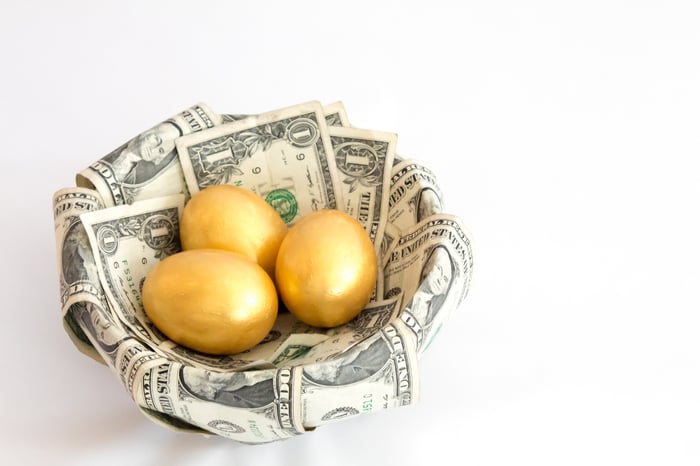There's no sugarcoating the fact that it's been an ugly year for Wall Street and everyday investors. The broad-based S&P 500 (^GSPC -0.58%) produced its worst first-half return since 1970, while the technology-dependent Nasdaq Composite (^IXIC -1.15%) has shed around a third of its value. Both of these major indexes entered a bear market during the second quarter, with the iconic Dow Jones Industrial Average (^DJI -0.12%) currently a bad day away from pushing into bear market territory.
The uncertainty, volatility, and velocity of downside moves during bear markets can be scary for retail investors and test their resolve to stick around. But history also shows that it's an incredible time to do some shopping. When given enough time, every single stock market correction and bear market throughout history has eventually been erased by a bull market.

Image source: Getty Images.
Nevertheless, buying individual stocks may not be as palatable in the short run, thanks to heightened volatility. That's where exchange-traded funds (ETFs) come into play. An ETF holds a basket of securities that allows investors to target specific strategies, industries, sectors, or indexes. In return for paying an annual expense ratio, which covers costs such as fund management fees, an ETF provides investors with as much or as little diversification as they choose with the simple click of a button.
What follows are the three best ETFs investors can buy right now with the stock market plunging.
Vanguard S&P 500 ETF
The first no-brainer ETF to buy as the market plunges is the Vanguard S&P 500 ETF (VOO -0.60%). This ETF attempts to closely mirror the daily movements of the benchmark S&P 500 Index.
For virtually all money managers, their goal is to surpass the return of the S&P 500. However, simply matching the total return of the S&P 500 over a long period of time can make an investor rich.
Every year, market analytics company Crestmont Research releases data that examines the rolling 20-year total returns, including dividends paid, for the S&P 500, and expresses these total returns as an annual average. Crestmont's data compiled the average annual return for 103 ending years (1919-2021) and found that investors would have made money in 103 out of 103 rolling 20-year periods. In other words, when you buy matters far less than how long you hold. History says it's a near-guarantee you'll make money if you buy an S&P 500 tracking index like the Vanguard S&P 500 ETF and hold it for 20 years.
You'll note that I chose the Vanguard S&P 500 ETF to buy and not the SPDR S&P 500 ETF (SPY -0.59%). The reason is subtle, but meaningful. The SPDR S&P 500 ETF sports a net expense ratio of 0.09%. This means investors will lose $0.90 of every $1,000 they invest in "SPY" to fees. Comparatively, the Vanguard S&P 500 ETF has a net expense ratio of just 0.03%, or $0.30 for every $1,000 invested. If you're investing quite a bit in an S&P 500 tracking index, the latter can save you quite a bit in fees while delivering effectively identical results.
Additionally, keep in mind that the S&P 500 shuffles new companies in and out of the index every year. Companies that underperform for long periods and lose market value can be given the heave-ho, while outperformers are added or stick around. This provides the fuel that pushes the S&P 500, and therefore the Vanguard S&P 500 ETF, higher over time.
iShares Russell 2000 Growth ETF
The second top-tier ETF investors can buy right now as the market plunges is the iShares Russell 2000 Growth ETF (IWO -1.28%).
In many respects, the iShares Russell 2000 Growth ETF represents everything that investors seem to be avoiding like the plague at the moment. This is an index that's packed with more than 1,100 small-cap stocks that are expected to grow at a faster pace than their peers for the foreseeable future. Pretty much anything having to do with "growth" and "small-cap stocks" has been taken to the woodshed in 2022 over concerns of higher interest rates and how that'll affect access to capital.
But there are plenty of reasons to be optimistic and treat the iShares Russell 2000 Growth ETF as a contrarian play to the upside. For starters, growth stocks have historically outperformed value stocks during periods of economic weakness (U.S. gross domestic product has retraced in each of the first two quarters of 2022). Although value stocks have the edge in terms of average annual return over the really long run, growth stocks have the upper hand when the U.S. economy weakens.
Furthermore, small-cap stocks tend to do their best during the early stages of a bull market and the initial recovery of the U.S. economy. Although we're clearly not at either of these points yet, predicting when the stock market will bottom or when the U.S. economy will trough is an exercise best left to hindsight. With small-cap stocks getting hit hard in 2022, they're a solid candidate to bounce back strongly in 2023 and/or 2024.
To build on this point, the iShares Russell 2000 Growth ETF had 1,115 holdings, as of Sept. 22, 2022, with the largest accounting for just 0.81% of invested assets. While small-caps are generally riskier investments than large-cap and mid-cap companies, spreading the fund's money across 1,115 holdings significantly reduces the risk of having stakes in unproven, but potentially game-changing, businesses.
As a final note, the iShares Russell 2000 Growth ETF's modest 0.46% yield more than covers its 0.23% net expense ratio.

Image source: Getty Images.
Vanguard Dividend Appreciation ETF
The third and final best ETF to buy as the market plunges is the Vanguard Dividend Appreciation ETF (VIG -0.37%).
As its name implies, the Vanguard Dividend Appreciation ETF purchases companies that have a track record of growing their payouts over time. Specifically, this ETF seeks to track the performance of the S&P U.S. Dividend Growers Index.
One reason to confidently buy the Vanguard Dividend Appreciation ETF is the track record of dividend stocks over long periods. In 2013, J.P. Morgan Asset Management released a report that compared the performance of companies initiating and growing their payouts to stocks that didn't offer a dividend over a 40-year stretch (1972-2012). The dividend-paying stocks delivered an average annual return of 9.5% over four decades, which absolutely ran circles around the stocks that didn't pay a dividend (1.6% annualized return).
In addition to the storied outperformance of income stocks, companies that pay a regular dividend to their shareholders are almost always profitable and time-tested. This means investors don't have to worry about these companies when inevitable recessions arise.
Diversification is yet another reason to be confident about the Vanguard Dividend Appreciation ETF making you richer over time. The fund held 289 stocks with a median market value of $143.9 billion, as of Aug. 31, 2022. Because periods of economic expansion last considerably longer than recessions and bear markets, the companies owned by this ETF are well-positioned to benefit from an expanding U.S. and global economy.
Lastly, you won't have to fork over much for this diversification. The Vanguard Dividend Appreciation ETF has a net expense ratio of a minuscule 0.06%. Comparatively, it's yielding 1.93%, which is 41 basis points higher than the yield you'd receive by owning the SPDR S&P 500 ETF.





